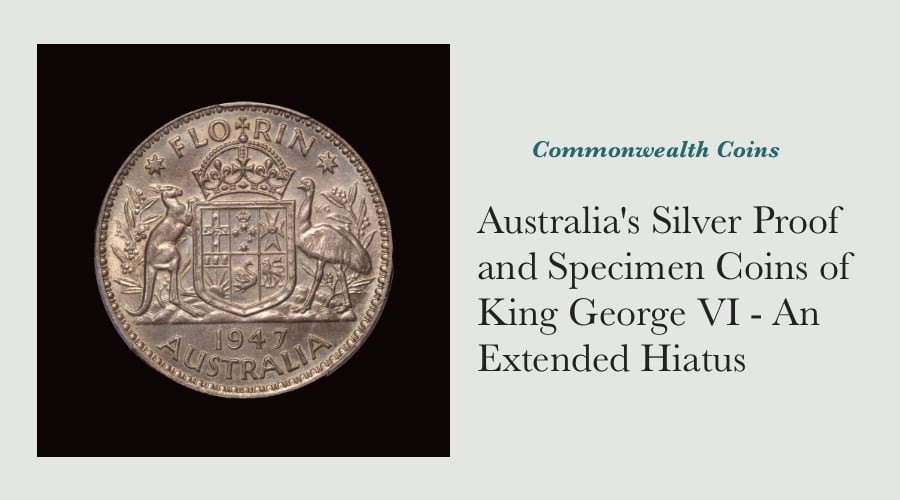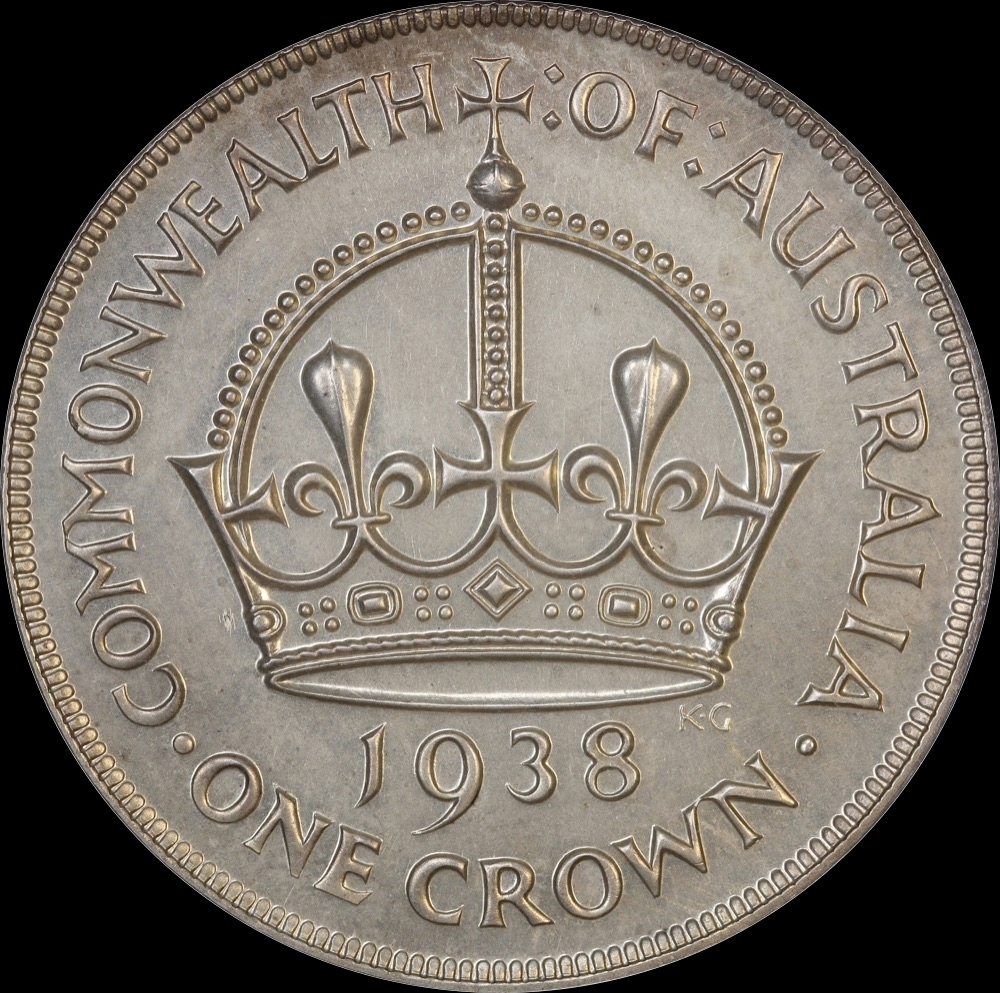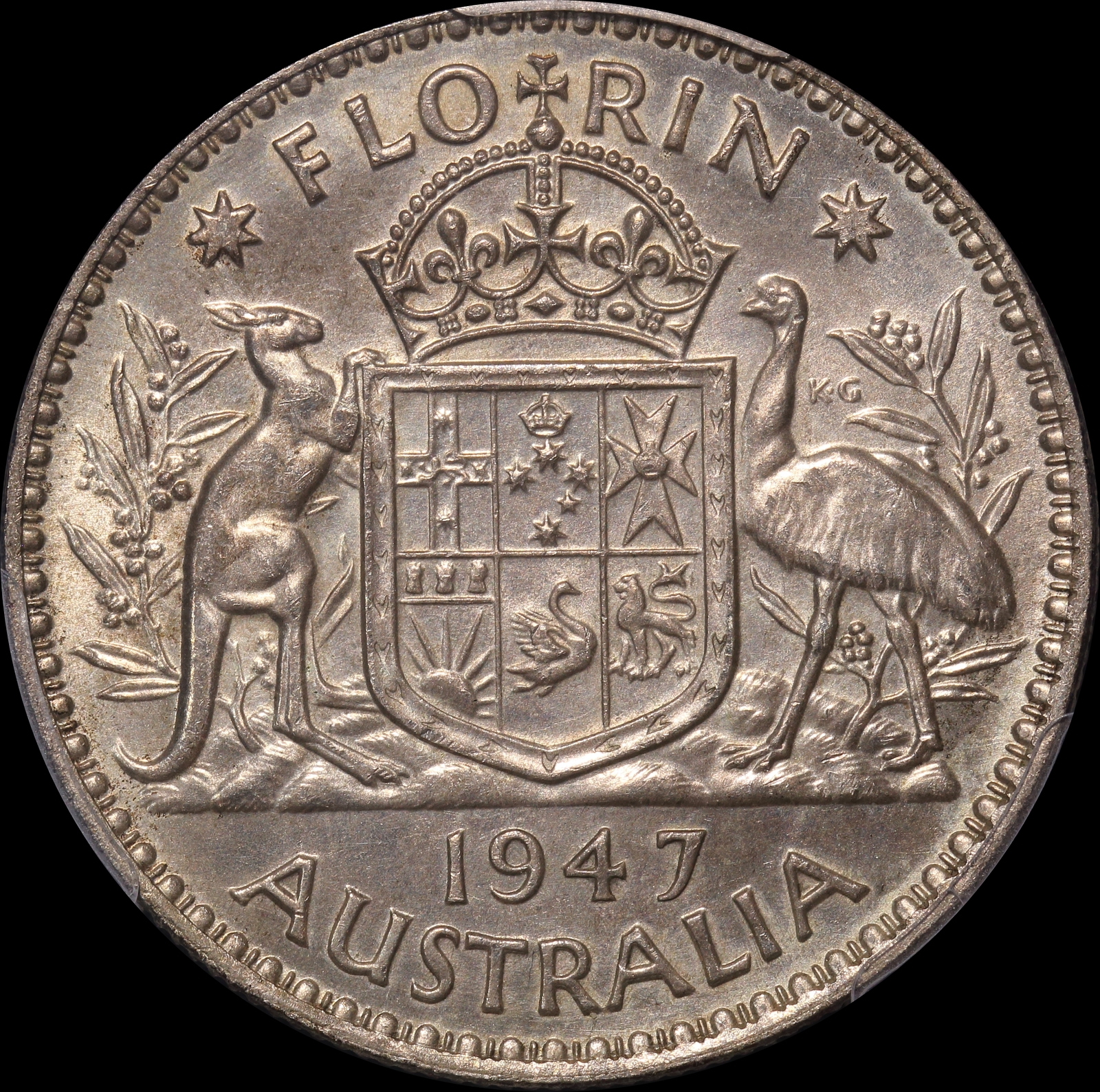Australia's Silver Proof and Specimen Coins of King George VI - An Extended Hiatus

The very first Australian silver coins struck during the reign of King George VI were keenly anticipated by the public. The portrait of the nation's new King was being seen for the first time, the 1937 crown was eagerly hoarded as a solid memento of the happy occasion.
More excitement for collectors came in 1938, when the mint struck 100 proofs of each of the newly designed circulating coins. These sets were followed by 100 proofs of the new halfpenny with the Kangaroo reverse that was released in 1939. This is the point at which the extended hiatus in proof and specimen coin production began.
The Outbreak of War and A Change in Policy

1938 Proof Crown
Image Source: Sterling & Currency
The primary reason for this stoppage in proof coin production was the outbreak of the Second World War in September 1939. "Staff shortages, and the fact that equipment and machinery were not able to be maintained as in normal circumstances, meant that ... more pressing matters of war took precedence." [1]
The other factor that influenced the production of proof coins by the Melbourne Mint during the reign of King George VI was the change in senior Mint staff, and the resulting change in focus and policy. In his role as Deputy Master between 1921 and 1926, Albert Malet le Souef played a key role in driving the growth of the Melbourne Mint's own numismatic collection.
Le Souef was proactive in initiating exchanges of Melbourne proof coins with other mints and public collections, this practice continued for at least a decade after his tenure ended. Alfred Kenyon was the Honorary Numismatic Curator between 1927 and 1942, during this time the Melbourne Mint's collection was deemed the "National Coin and Medal Collection".
The rigours of war on the public purse meant no funds were allocated to growing the collection between 1939 and 1945, and further that proof coins were not struck by Melbourne for commercial reasons again until the coronation of Elizabeth II in 1953. The only silver proof coins dated between 1939 and 1951 and struck by an Australian mint that are available to collectors were struck as a record of production.
The Silver Proof, Pattern and Specimen Coins of King George VI
| Mint | 3d | 6d | 1/- | 2/- | Federation 2/- | 5/- | Comment | |
| 1937 | Melbourne | - | - | - | - | - | 100 | Struck for the Coronation of KGVI |
| 1937 | London | Unknown | - | Unknown | Unknown | - | - | Patterns, uniface and double-sided |
| 1938 | Melbourne | 100 | 100 | 100 | 100 | - | 52 | Struck for 150th anniversary celebrations |
| 1939 | Melbourne | - | - | Unknown | - | - | - | Single example sighted in Noble Numismatics auctions in 1980?s |
| 1940 | Melbourne | Unknown | Unknown | Unknown | - | - | - | Mixed-date specimen set in presentation case |
| 1941 | Melbourne | - | - | - | Unknown | - | - | |
| 1942 | - | - | - | - | - | - | ||
| 1943 | - | - | - | - | - | - | ||
| 1944 | - | - | - | - | - | - | ||
| 1945 | Melbourne | - | - | 2 | 2 | - | - | Last coins struck by Melbourne in 92.50% silver |
| 1945 | Melbourne | - | - | - | Unknown | - | - | Patterns struck in 50% and 66% pure silver |
| 1946 | Melbourne | - | - | - | 4 | - | - | Patterns struck in copper-nickel |
| 1946 | Perth | - | - | Unknown | - | - | - | 2 examples held in Perth Mint archival collection |
| 1947 | Melbourne | - | - | - | Unknown | - | - | A single example is known in private hands |
| 1948 | - | - | - | - | - | - | ||
| 1949 | - | - | - | - | - | - | ||
| 1950 | - | - | - | - | - | - | ||
| 1951 | London | Unknown | Unknown | Unknown | Unknown | - | - | Proofs struck by the London Mint |
| 1951 | London | - | - | - | - | Unknown | - | Pattern struck in copper-nickel |
| 1952 | - | - | - | - | - | - |
1939 Shilling: A single proof 1939 shilling was seen at auction twice in the 1980's, there is no record of the reason for its production.
1940/1 Specimen Set: A cased set of coins dated 1940 - 1941 was offered for sale in a Downie's auction in October 2013, it is the only such set ever sighted and was presented to a former staff member of the Melbourne Mint.
1945 Florin and Shilling: Melbourne Mint records show that 2 proofs were retained of the last silver florins and shillings struck in 92.5% silver. [2]
1945 Patterns: Museum Victoria holds several experimental silver patterns that were struck in 50% and 66% silver alloys. [3]
1946 Patterns: The Museum Victoria website states that 4 pattern florins were struck in copper nickel in October 1946 "...to show what copper-nickel coins might look like should the use of silver be discontinued." [4]
1946 Perth Shillings: The Museum Victoria collection contains 3 1946 Perth shillings that are described as proofs, 2 similar coins are held in the Perth Mint archival collection. None are known in private hands.
1947 Florin and Threepence: Just one proof example of this coin is known in private hands, it is ex the Jerome Remick collection. A similar example is held in the Museum Victoria collection, along with a specimen 1947 threepence.
1951-PL Proof Set: The Royal Mint in London struck several sets of proof coins representing the Australian denominations they struck throughout 1951. The mintage figure of these sets is not known.
1951 Federation Jubilee Florin: The Royal Mint struck several patterns of the Federation Jubilee Florin in copper-nickel, at least one of these is known in private hands.
The above records and table confirm the conclusion made by John Sharples that "The last public issue of a proof before the series which began in 1955, was of the 1939 kangaroo halfpenny." [5]
The Proof 1947 Florin – A 39 million to One Coin

1947 Proof Florin
Image Source: Sterling & Currency
The 1947 florin has the highest mintage out of the entire Australian florin series - 39,292,800 were struck. The reason for this backlog seems to be found in the need for legislative change before coins with the reduced alloy could be distributed. Commentary by John Sharples posted on the Museum Victoria website advises that "Coins in the new alloy were stockpiled through 1946 and were released after the necessary legislation was passed in 1947." [6]
The Coinage Act 1947 was assented to on June 10th 1947 and commenced on July 8th 1946. Numerous contemporary media articles announced the introduction of the new coins into circulation and pointed out that "...they were likely to become collectors' pieces." [7]
The reason for this was the legend placed around the rim of the obverse - it included the term 'IND IMP', which described the King in Latin as "Emperor of India". That title was to lapse when India and Pakistan became independent on August 15th, 1947 - a matter of weeks after the coins were introduced into circulation. The next Australian florins to be released in 1951 did not have this title included in it.
We can only imagine just how much keen interest there would have been in the new florins when they were released - collectors and the public would have been keen to literally get a feel for the new weight, and to check the controversial obverse legend. It is incredible to think there is just one 1947 proof coin available to collectors, yet more than 39 million were struck for circulation.
--------------
[1] Rees; Peter, "Inside the Vault", Royal Australian Mint, Sydney, 2016, p 96.
[2] Sharples; John, "The Numismatic Collection of The Museum Of Victoria" in the Journal of the NAA, Volume 2, Article 3, 1986, p 49.
[3] https://collections.museumsvictoria.com.au/items/55913
[4] https://collections.museumsvictoria.com.au/items/55909
[5] Sharples; John, "On Collecting Commonwealth Coins" in the Journal of the NAA, Volume 5, 1990, p 21.
[6] https://collections.museumsvictoria.com.au/articles/3781
[7] NEW FLORINS MAY BE COLLECTORS' PIECES" The Courier-Mail (Brisbane, Qld. : 1933 - 1954) 8 July 1947: p3.